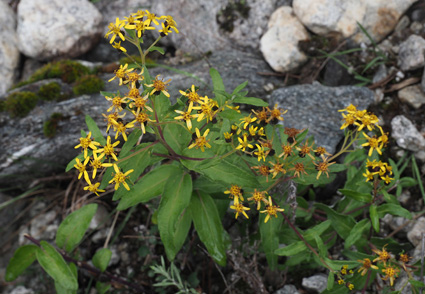Abstract
Synotis nyalamensis (Asteraceae, Senecioneae), a new species from Nyalam county in southern Xizang (Tibet), China, is described and illustrated. It is most closely similar to S. kunthiana, a species occurring in northwestern India, Nepal, and Pakistan, in having abaxially white-tomentose leaves and cylindric-campanulate capitula, but differs by having higher stature (45–60 vs. 20–40 cm), singular (vs. several) stems, caudate-acuminate (vs. acuminate) leaf tips, prominent (vs. obscure) nerves on abaxial side of leaves, and more disk florets (15–24 vs. 7–12).
References
Chen, Y.L., Nordenstam, B. & Jeffrey, C. (2011) Synotis (C. B. Clarke) C. Jeffrey & Y.L. Chen. In: Wu, Z.Y, Raven, P.H. & Hong, D.Y. (Eds.) Flora of China, vols. 20–21. Science Press, Beijing & Missouri Botanical Garden Press, St. Louis, pp. 489–505.
Clarke, C.B. (1876) Compositae Indicae. Thacker, Spink and Co., Calcutta, 347 pp.
IUCN Standards and Petitions Subcommittee (2019) Guidelines for Using the IUCN Red List Categories and Criteria version 14[EB/OL]. 2020-04-10. Prepared by the Standards and Petitions Subcommittee. [https://www.iucnredlist.org/documents/RedListGuidelines.pdf]
Jeffrey, C. & Chen, Y.L. (1984) Taxonomic studies on the tribe Senecioneae (Compositae) of Eastern Asia. Kew Bulletin 39: 205?446. [https://www.jstor.org/stable/4110124?seq=1]
Li, H.M., Lazkov, G.A., Illarionova, I.D., Tong, T.J., Shao, Y.Y. & Ren, C. (2018) Transfer of Senecio karelinioides (Asteraceae-Senecioneae) to Synotis based on evidence from morphology, karyology and ITS/ETS sequence data. Nordic Journal of Botany 32: 1–12. [https://onlinelibrary.wiley.com/doi/abs/10.1111/njb.01838]
Li, Z., Zheng, H.L. & Tang, M. (2020) Synotis panzhouensis (Asteraceae, Senecioneae), a distinct new species with red-purple pappus from southwestern Guizhou, China. Phytokeys 166: 79–86. [https://phytokeys.pensoft.net/article/58654/]
Ling, Y. (1937) Compositae sinenses novae vel minus cognitae I. Contributions from the Institute of Botany, National Academy of Peiping 5: 1–30.
Linnaeus, C. (1753) Species Plantarum. Laurentius Salvius, Holmiae, 1200 pp.
Liu, Y.L., Zhang, R., Ren, C., Liu, B., Zhang, Y. & Tang, M. (2020) On the specific identity of Chinese endemic species Synotis longipes (Compositae-Senecioneae). Phytotaxa 472: 269–276. https://doi.org/10.11646/phytotaxa.472.3.5
Liu, Y.L., Zhu, X.X., Peng, Y.L. & Tang, M. (2021) Synotis jinshajiangensis (Asteraceae: Senecioneae), a new species from northwestern Yunnan, China. Phytotaxa 478: 162–170. https://doi.org/10.11646/phytotaxa.478.1.12
Schischkin, B. (1961) Senecio L. In: Schischkin, B. & Bobrov, E.G. (Eds.) Flora SSSR, vol. 26. Akademiya Nauk SSSR Publishers, pp. 699–778.
Tang, M. (2014) A Systematic Study of the Genus Synotis (Compositae-Senecioneae). Ph.D. thesis. University of Chinese Academy of Sciences, Beijing.
Tang, M. & Chen, Y.S. (2021) Blumea hunanensis is a synonym of Synotis nagensium (Asteraceae: Senecioneae). Phytotaxa 487: 149–156. https://doi.org/10.11646/phytotaxa.487.2.5
Tang, M., Ren, C. & Yang, Q.E. (2014) Parasenecio chenopodiifolius (Compsositae- Senecioneae) is a Synotis and conspecific with S. otophylla based on evidence from morphology, cytology and ITS/ETS sequence data. Nordic Journal of Botany 32: 824–835. https://doi.org/10.1111/njb.00574
Tang, M., Ren, C. & Yang, Q.E. (2017) Reinstatement of the Sino-Himalayan species Senecio pentanthus (Asteraceae, Senecioneae). Phytotaxa 292: 253–261. https://doi.org/10.11646/phytotaxa.292.3.5
Tang, M. & Yang, Q.E. (2014) Two newly recorded species of Synotis (Asteraceae-Senecioneae) in China. Journal of Tropical and Subtropical Botany 22: 215–220. [http://jtsb.scib.ac.cn/jtsb_cn/ch/reader/view_abstract.aspx?file_no=3039&flag=1]
Tong, T.J., Tang, M., Ren, C. & Yang, Q.E. (2017) Senecio kumaonensis (Asteraceae, Senecioneae) is a Synotis based on evidence from karyology and nuclear ITS/ETS sequence data. Phytotaxa 292: 35–46. https://doi.org/10.11646/phytotaxa.292.1.3
Winkler, C.G.A. (1890) Decas septima Compositarum novarum Turkestaniae nec non Bucharae incolarum. Trudy Imperatorskago S.-Peterburgskago Botaniceskago Sada 11: 275–288.
Zhang, R., Liu, Y.L. & Tang, M. (2021) Four new synonyms in Synotis (Asteraceae, Senecioneae). Phytotaxa 483: 255–266. https://doi.org/10.11646/phytotaxa.483.3.5


